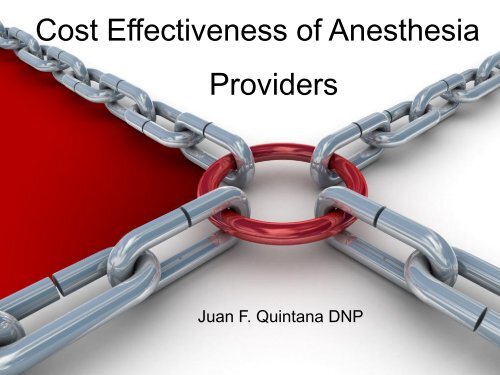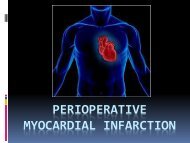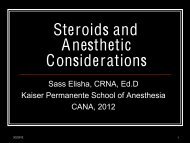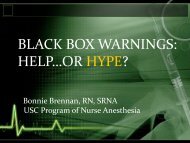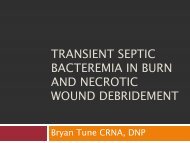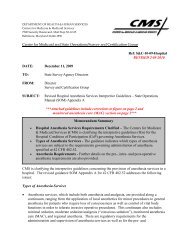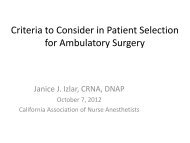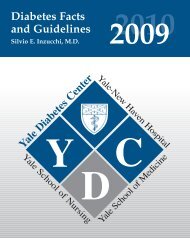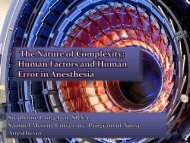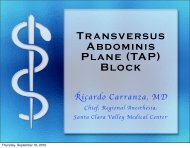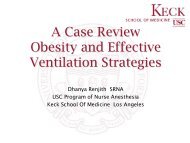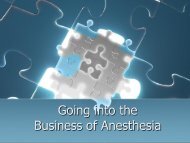Cost Effectiveness and Anesthesia Providers
Cost Effectiveness and Anesthesia Providers
Cost Effectiveness and Anesthesia Providers
Create successful ePaper yourself
Turn your PDF publications into a flip-book with our unique Google optimized e-Paper software.
<strong>Cost</strong> <strong>Effectiveness</strong> of <strong>Anesthesia</strong><br />
<strong>Providers</strong><br />
Juan F. Quintana DNP
The <strong>Cost</strong> <strong>Effectiveness</strong> of <strong>Anesthesia</strong> Study<br />
conducted by the Lewin Group<br />
has been funded in collaboration with the<br />
AANA <strong>and</strong> AANA Foundation
Outline<br />
• Purpose<br />
• Education<br />
<strong>Cost</strong> <strong>Effectiveness</strong> of Educating CRNAs<br />
• Quality<br />
Claims Information<br />
• <strong>Anesthesia</strong> Practice Models<br />
<strong>Cost</strong> Effective <strong>Anesthesia</strong> Delivery Models<br />
• Access<br />
The Value Added Component
Purpose<br />
• Assess the cost effectiveness of CRNAs<br />
<strong>and</strong> Anesthesiologists with regard to<br />
<strong>Cost</strong> of Education, Quality of Care, <strong>Cost</strong><br />
<strong>Effectiveness</strong> of <strong>Anesthesia</strong> Practice<br />
Models <strong>and</strong> Access to Care.
Education
Educational <strong>Cost</strong> - Literature Review<br />
(all estimates converted to 2008 dollars)<br />
CRNA Education<br />
$52,076 (Direct <strong>Cost</strong>) Gunn (1996)<br />
$287,382 (Social <strong>Cost</strong>) Fagerlund (1998)<br />
MD (PGY 2-4)<br />
$321,000 (Direct <strong>Cost</strong>) Dodoo, Phillips (2008)<br />
$301,178 (Direct <strong>Cost</strong>) Franzini, Berry (1997)<br />
$-114.031 (Direct + productivity) Franzini, Berry (1997)<br />
$245,969 (+ opportunity cost) Franzini, Berry (1997)<br />
modified by Hogan to include opportunity cost<br />
$229,267 (Direct, before GME offset) Pisetsky, Lubarsky, et<br />
al (1998)<br />
$-213,000 (w/ productivity offset + GME subsidy) Pisetsky,<br />
Lubarsky, et al (1998)<br />
$146,940 Pisetsky, et al (1998) w/ productivity offset with<br />
opportunity cost (Hogan)
Educational <strong>Cost</strong>-<br />
Lewin Group<br />
• Three types of cost included:<br />
– Direct education costs<br />
– Opportunity cost of student/resident’s time<br />
– Value of student/resident services while<br />
training
Educational <strong>Cost</strong><br />
Assessment<br />
CRNA<br />
Direct:<br />
Pre-<strong>Anesthesia</strong>: $53,696<br />
<strong>Anesthesia</strong>: $68,465<br />
Opportunity: $291,353<br />
Productivity: - $251,704<br />
Total: $161,809<br />
Anesthesiologist<br />
Direct:<br />
Pre <strong>Anesthesia</strong>: $623,818<br />
<strong>Anesthesia</strong>: $494,420<br />
Opportunity: $897,793<br />
Productivity: - $775,073*<br />
Total: $1,083,795
<strong>Anesthesia</strong> <strong>Providers</strong><br />
Produced<br />
CRNA<br />
670<br />
$$$<br />
MDA<br />
100
Conclusions:<br />
Educational <strong>Cost</strong><br />
• Direct costs <strong>and</strong> Economic cost of educating CRNAs are<br />
significantly lower than the cost of anesthesiologists<br />
– Economic costs of graduate education for CRNA are 1/4th the cost<br />
of anesthesiologists<br />
– Total education costs of CRNAs are about 15% of the cost of<br />
anesthesiologists<br />
• Key cost drivers:<br />
– Faculty cost <strong>and</strong> student-faculty ratio<br />
– Program length<br />
– Student opportunity cost<br />
– Productivity of students in clinical portion of graduate education
Quality
Quality:<br />
Literature<br />
Majority - no statistically significant difference between anesthesiologists <strong>and</strong><br />
CRNAs after controlling for other relevant factors<br />
– Minnesota Department of Health, 1995<br />
– Cromwell, 1999, Posner & Freund, 1999<br />
– Hoffman, Thompson, Burke, & Derkay, 2002<br />
– Pine, Holt, & Lou, 2003; Smith, Kane, & Milne, 2004<br />
– Simonson, Ahern, & Hendryx, 2007<br />
– Needleman & Minnick, 2008<br />
– RTI & Cromwell, 2010<br />
• Exceptions: Silber et al 2000<br />
• <strong>Anesthesia</strong> Complications for Analyses: Donnelly & Buechner, 2001
Quality:<br />
Records Review<br />
Nationwide Inpatient Sample (NIS) 2007 data<br />
N % Weighted N %<br />
No 8,034,162 99.88% 39,496,584 99.89%<br />
Yes 9,253 0.12% 45,364 0.11%<br />
Ingenix National Database<br />
N = 52,636 claims;<br />
No complications<br />
National Survey of<br />
Ambulatory Surgery (NSAS)<br />
N = 52,233*,<br />
Weighted N = 34,738,440
Conclusions:<br />
Quality<br />
• Incidence of complications due to anesthesia, regardless of<br />
delivery model, is low <strong>and</strong> declining<br />
• With some exceptions, literature suggests no statistically<br />
significant difference in complication rates or mortality rates<br />
between CRNA <strong>and</strong> anesthesiologists<br />
• Analysis of claims data is consistent with very low incidence<br />
of complications, <strong>and</strong> no differences between provider type
<strong>Anesthesia</strong><br />
Practice Models
<strong>Cost</strong> <strong>Effectiveness</strong>:<br />
Literature Review<br />
Simulation Analyses<br />
• Abenstein et al (2004), data from Silber et al (2000)<br />
• Medical direction model is more cost effective with respect to QALY’s than a<br />
model in which CRNAs act independently<br />
• Data is NOT based on mortality due to anesthesia (Silber Study)<br />
• Variation in delivery models may be correlated with variation in other factors<br />
affecting quality of care or patient risk.<br />
• Glance (2000)<br />
• Anesthesiologist model not cost-effective<br />
• Direction-models are cost effective, with ratios varying optimally based on<br />
risk class of case.<br />
• Subjective estimates of risk<br />
• Not clear how a given setting could adjust quickly to different models<br />
depending on risk
<strong>Cost</strong> <strong>Effectiveness</strong>:<br />
Literature Review<br />
Simulation Analyses<br />
Quintana (2009) estimated costs associated<br />
with a number of different delivery models<br />
• Quality outcomes are held constant<br />
• Anesthesiologist intensive forms of delivery are<br />
less efficient, <strong>and</strong> more likely to require<br />
subsidization by the hospital
<strong>Anesthesia</strong><br />
Practice Models<br />
<strong>Cost</strong> Effective<br />
12 ORs<br />
High / Low<br />
Dem<strong>and</strong><br />
CRNA<br />
MDA<br />
ACT<br />
Collaborative<br />
(Supervision)<br />
H -<br />
<br />
H -<br />
<br />
H - -<br />
H -<br />
<br />
L -<br />
<br />
L -<br />
<br />
L -<br />
<br />
L - -
<strong>Cost</strong> <strong>Effectiveness</strong><br />
Conclusions:<br />
Simulation Analyses<br />
• CRNAs acting independently is the MOST cost efficient model<br />
<strong>and</strong> MOST attractive financially<br />
• Where dem<strong>and</strong> is high, supervisory model (1:4+) <strong>and</strong> direction model (1:4)<br />
become relatively more attractive financially<br />
–Supervisory (Collaborative) model is the second least costly model<br />
• When dem<strong>and</strong> is constrained, models which require larger dem<strong>and</strong> become<br />
less cost effective<br />
• There are no circumstances examined in which a 1:1 direction model is cost<br />
effective or financially viable<br />
• When dem<strong>and</strong> is highly uncertain, CRNAs acting independently becomes<br />
relatively more attractive financially
Claims Analysis<br />
Average Billed<br />
Delivery Model<br />
Anesthesiologist<br />
only<br />
N<br />
33,24<br />
9<br />
Average<br />
Billed<br />
Amount<br />
$1,087.15<br />
Direction 1:2-4 11,022 $1,434.19<br />
Direction 1:1 2,021 $1,544.36<br />
CRNA only 6,344 $1,059.34
Claims Analysis<br />
Allowed Amounts<br />
Delivery Model N Allowed<br />
Amount<br />
Anesthesiologist<br />
only<br />
33,249 $470.54<br />
Direction 1:2-4 11,022 $438.13<br />
Direction 1:1 2,021 $477.57<br />
CRNA only 6,344 $307.23
Conclusions:<br />
Claims Analysis<br />
<strong>Cost</strong> Effective<br />
Billed Amounts<br />
CRNA < all other models<br />
Lowest to highest cost<br />
– CRNA only<br />
– Anesthesiologist<br />
only<br />
– Direction 1: 2-4<br />
– Direction 1:1<br />
Reimbursed Amount<br />
CRNA < all other models<br />
Lowest to highest cost<br />
–CRNA only<br />
–Direction 1:2-4<br />
–Anesthesiologist only<br />
–Direction 1:1
Claims Analysis<br />
Caveat<br />
Delivery Model N % Cases<br />
Anesthesiologist only 33,249 63%<br />
Direction 1:2-4 11,022 21%<br />
Direction 1:1 2,021 4%<br />
CRNA only 6,344 12%<br />
Total 52,636 100%
Access
Access:<br />
The Value Added Component<br />
CRNAs as the primary anesthesia providers<br />
in the rural United States provide a Value Added<br />
Component.<br />
All things being equal (which they are not) we bring<br />
more to the table
Access to Care: CRNAs per Population<br />
CRNAs Are in Most Counties of the Country
Access to Care: Anesthesiologists per<br />
Population Concentrated in Urban Areas
Percent<br />
Percentage of Urban Counties by<br />
<strong>Anesthesia</strong> Provider Type<br />
80%<br />
70%<br />
71%<br />
60%<br />
50%<br />
40%<br />
30%<br />
No Anesthesiologists/CRNAs<br />
CRNAs Only<br />
Anesthesiologists Only<br />
Anesthesiologists <strong>and</strong> CRNAs<br />
20%<br />
10%<br />
9%<br />
16%<br />
4%<br />
0%<br />
<strong>Anesthesia</strong> Provider Type
Percent<br />
Percentage of Rural Counties by<br />
<strong>Anesthesia</strong> Provider Type<br />
40%<br />
35%<br />
34%<br />
35%<br />
30%<br />
27%<br />
25%<br />
20%<br />
15%<br />
No Anesthesiologists/CRNAs<br />
CRNAs Only<br />
Anesthesiologists Only<br />
Anesthesiologists <strong>and</strong> CRNAs<br />
10%<br />
5%<br />
0%<br />
4%<br />
<strong>Anesthesia</strong> Provider Type
Conclusions:<br />
Access<br />
• CRNAs significantly exp<strong>and</strong> access to<br />
anesthesia services across the county<br />
• Lower cost<br />
• Greater physical access<br />
• Particularly exp<strong>and</strong> care to rural areas<br />
• Value Added Component
Summary<br />
CRNAs are 6x more <strong>Cost</strong> Effective to Educate than<br />
Anesthesiologists<br />
Quality of <strong>Anesthesia</strong> services is better than it ever has been<br />
without significant differences between CRNA <strong>and</strong><br />
Anesthesiologists<br />
Increased CRNA autonomy <strong>and</strong> more precisely<br />
Independence improves the Practice Models:<br />
<strong>Cost</strong> <strong>and</strong> Efficiency<br />
CRNAs provide the Healthcare system the Value Added<br />
Component of increased Access to anesthesia services in<br />
Rural America
<strong>Cost</strong> <strong>Effectiveness</strong><br />
Technical Advisory Panel<br />
• Nancy Bruton-Maree, CRNA, MS<br />
• Larry G. Hornsby, CRNA, BS<br />
• Betty J. Horton, CRNA, PhD<br />
• Kenneth C. Plitt, CRNA, MBA<br />
• Juan F. Quintana, CRNA, DNP<br />
• Paul Santoro, CRNA, MS<br />
• Jim Scarsella, CRNA, MSF<br />
• Bruce A. Schoneboom, CRNA, PhD, FAAN<br />
• James Walker, CRNA, DNP<br />
• Lorraine M. Jordan, CRNA, PhD (Staff)
Juan F. Quintana CRNA, DNP<br />
Sleepy <strong>Anesthesia</strong> Associates PLLC<br />
364 Private Road 8581<br />
Winnsboro, TX 75494<br />
a_sleeper2@yahoo.com<br />
The Lewin Group<br />
3130 Fairview Park Drive<br />
Suite 800<br />
Falls Church, VA 22042<br />
Main: (703) 269-5500<br />
www.lewin.com


